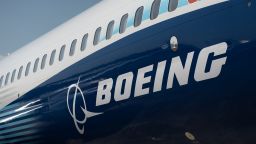Losses continued to mount for Boeing, as the supply chain problems caused higher-than-expected losses.
The company reported a loss of $1.27 per share, excluding special, one-off charges and gains. Although that was an improvement from the $2.75 a share it lost on that basis a year earlier, it marked the seventh-straight quarter in which Boeing reported a loss, excluding one-time items.
Since the grounding of the 737 Max in March of 2019, following two crashes that killed 346 people, Boeing has reported only one quarterly profit without the help of special items.
The loss was worse than the forecast of a $1.07 a share from analysts surveyed by Refinitiv. And those analysts don’t expect a near-term end of the red ink at Boeing, with another loss forecast for the current quarter. Wall Street expects only narrow profits in the second half of the year, which are expected to leave Boeing with an annual loss for the fifth-straight year.
The company disclosed earlier this month that a “significant number” of 737 Max jets in production had been affected by a “non-standard manufacturing process” by one of its suppliers which would affect near-term deliveries and production.
But Boeing reaffirmed its earlier guidance that it expects have a positive cash flow this year, and said it expects to build 38 737 Max jets a month later this year, and to deliver 400 to 450 of the planes.
Company executives said, despite these latest problems with the 737 Max, its financial results show progress for the company, because its loss is smaller than its loss from a year earlier.
“We continue to make real progress, steady progress in our recovery,” said CEO Dave Calhoun. “Challenges remain. There’s more to do. But overall, we feel good about the operational and financial outlook.”
Calhoun insisted both Boeing and its supplier Spirit AeroSystems (SPR) know how to fix the problems that were discovered with the 737 Max assembly and that there is no risk to the planes that are already in operation. But he confirmed that deliveries will be delayed in the coming months, which will affect the ability of some Boeing customers to fly the full schedule of flights they had intended this summer.
“We feel terrible about that,” he said.
But the Max is not the only plane for which Boeing is trying to recover from problems. The 787 Dreamliner had deliveries halted for about a year due to quality control issues and only resumed deliveries in September. The company booked $379 million in increased costs for the 787 program in the first quarter along with an undisclosed amount of compensation to airline customer which had deliveries delayed. It also still has some of the 787 Dreamliners that need modification in its inventory.
Boeing traditionally has not had inventory of completed planes, delivering them and receiving payment soon after completing assembly. But it has been stuck with unusually high inventory numbers ever since it continued production of the 737 Max during its 20-month grounding. It still has 225 of the Max in inventory, with 138 of those planes awaiting delivery to China.
While Chinese aviation authorities are again allowing the 737 Max to fly there, Chinese airlines have yet to accept delivery of any of those planes. The rising trade tensions between the United States and China have essentially shut Boeing out of that key market for several years now.
“We are working very hard to regain China,” Calhoun told investors.
Still despite all the continued problems and bigger than forecast loss, Boeing (BA)’s assurances on cash flow and full-year 737 Max deliveries helped lift shares of Boeing (BA) 3% in midday trading.


























